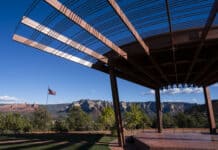Residents have seen the usual uptick in traffic this spring, with seasonal monumental delays.
The traffic adjustments in Uptown — jaywalking barriers, the temporary median and police officers controlling the lights — have helped, but there is little anyone can do to speed up traffic on State Route 179. West Sedona has seen clogs at the lights and slowgoing from Soldier Pass Road to Arroyo Piñon Drive.
The consulting firm Kimley-Horn is helping the city draft a Transportation Master Plan. Phase Two of the study will be public outreach component: Meetings and forums tentatively scheduled for May that will attempt to glean ideas from the public about how to implement some of the options residents said they wanted.
The city will hopefully use the final document to plan future traffic improvements.
If residents sincerely want to improve traffic conditions in Sedona, we will need to honest with ourselves.
Sedona is not and has never been a stagnant city. A cursory glance through our annual Sedona History section or a visit to the Sedona Heritage Museum reveals our hometown has been an evolving creature since J.J. Thompson homesteaded here.
New roads, wider roads or other traffic improvements may change what we’re used to but we must see the benefit these projects are for residents, just as we have done since the 1890s.
Some residents erroneously complain that the sole problem is the Sedona Chamber of Commerce is bringing too many tourists here and the city should cut funding, but this is predicated on a post hoc ergo propter hoc logical fallacy. Tourists come because Sedona became a tourist destination long before the city ever existed.
The chamber’s sole purpose is to help its member businesses survive so that they can provide us with products, services and luxuries and, most importantly, employ our residents. If Sedona had some other industry, we could rely less on outsiders to fund our tax revenue and economy but the fact is, tourism is our lifeblood and vast number of residents can afford to live here because they work for restaurants, shops, hotels, resorts, tour companies, spas and stores that primarily serve visitors.
As governments which can build roads, the city, the counties and the state are responsible for our roads and how drivers navigate them. Thus, it is up to residents to tell our governments how we want them to improve what they have jurisdiction over.
Perhaps the No. 1 problem the city faces are NIMBYs — Not In My Back Yard residents. They definitely want change, but if it’s next to their property, it’s sacrilege. This simply isn’t how a community works, nor should we let this myopic vision hinder real improvements that benefit the whole of the city, nor should elected officials let a tiny vocal minority hinder improvements benefitting all.
In November 2015, we published a two-page spread, “A Comprehensive List of Potential Improvements to Fix Sedona Traffic” that summarized decades of options, fixes and suggestions of the worst areas into a single map. I will also include a link to that page in the online version of this editorial. Some of these options are again on the table and some may be part of the final master plan.
When the city announces the dates of the public forums, please attend and make your opinions known.
We must put aside our pettiness and focus on real solutions that will benefit us all.
Christopher Fox Graham
Managing Editor


















